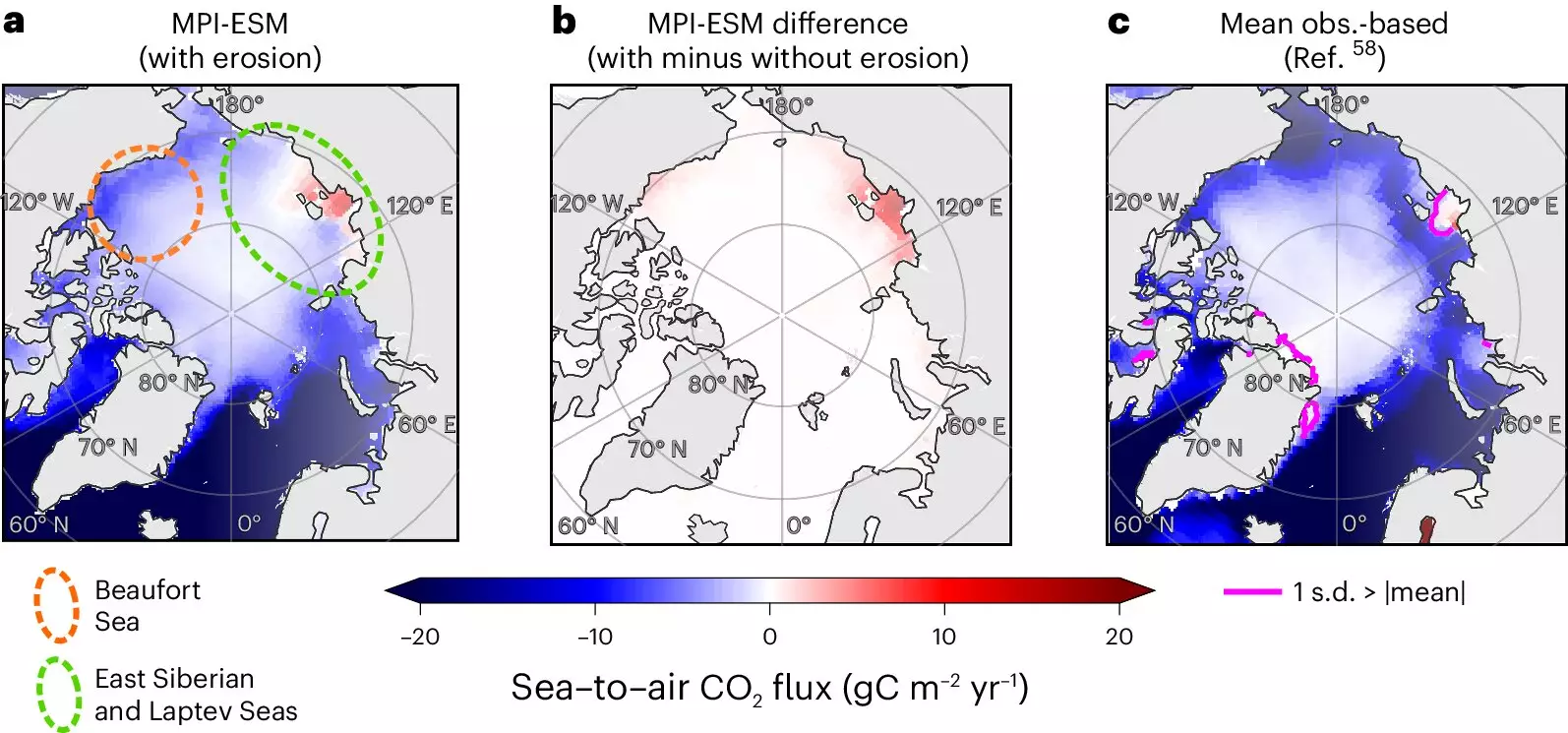Recent research underscores a troubling trend: as global temperatures rise, the Arctic Ocean’s capacity to sequester carbon dioxide (CO2) is in jeopardy. The combative forces of climate change, exemplified by the thawing of permafrost and increased coastal erosion, are causing a detrimental shift in the Arctic’s output of greenhouse gases. A pivotal study published in *Nature Climate Change* articulates how these physical alterations in the Arctic could precipitate an alarming rise in atmospheric CO2 levels, amounting to an increase that mirrors 10% of the total car emissions recorded in Europe for the year 2021.
Lead author David Nielsen from the Max Planck Institute for Meteorology highlights a critical assessment: the Arctic Ocean is no longer the reliable carbon sink it once was. “For the first time, we can actually put a sign—maybe not a number but a sign—on the change in the Arctic Ocean’s ability to absorb CO2 from the atmosphere due to coastal erosion,” Nielsen stated, emphasizing the negative implications this bears for our climate.
The issue stems from the accelerated thawing of permafrost, a phenomenon that has been intensified by human-driven climate change. Historically, permafrost has provided a substantial storage facility for carbon, holding an estimated 2.5 times more carbon than currently exists in the atmosphere. This reservoir is under siege as the summer months increasingly showcase thawed soil, paving the way for oceanic waves and storms to erode coastal land. The simulations conducted in this study project that by the end of the century, coastal erosion and the subsequent loss of permafrost could diminish the Arctic Ocean’s CO2 absorption capacity by more than 14 million tons annually.
This staggering figure prompts grave concerns among climatologists regarding the feedback loops induced by the loss of permafrost. Each rise in temperature could not only spur additional thawing but could lead to further CO2 release, thus perpetuating a cycle of warming that challenges the Earth’s existing carbon cycle.
The study’s findings spotlight significant “hot spots” for permafrost erosion, notably Drew Point in Alaska, the Mackenzie River Delta in Canada, and areas in Siberia. Each of these regions is experiencing localized consequences, such as ocean acidification and detrimental impacts on coastal ecosystems. The ramifications extend beyond ecological stigma; coastal communities like Shishmaref in Alaska are facing existential threats from rising sea levels and intensifying storm patterns, which are significantly eroding their geographical identity and cultural heritage.
The data indicating a 7% decrease in Arctic sea ice extent since the 1970s underlines the need for immediate attention to these rapidly altering landscapes. However, the equilibrium has altered even further: the warming permafrost is projected to disappear at alarming rates, with some models suggesting near-total loss by the year 2100.
The implications of permafrost erosion on CO2 levels are multifaceted and complex. This study serves as a clarion call for more extensive research into the interactions of various climate mechanisms. As noted by Kay McMonigal, an expert in physical oceanography, while this study focuses on specific regions, the impacts observed in the Arctic will invariably influence global climate dynamics. A feedback loop is anticipated, which would enable a continual release of CO2 with every degree of global warming—elevating atmospheric levels by an estimated 1.1 million to 2.2 million tons annually per Celsius degree increase.
Nielsen advocates for the continued urgency of research to delineate the precise mechanisms of this erosion, acknowledging that although these contributions to global emissions are relatively small—only representing about 0.1% of human-caused emissions—they are nonetheless critical. The real challenge lies in the inextricable relationship between anthropogenic activities and the climate’s response. The unfolding crisis serves as a reminder that without significant reductions in fossil fuel consumption, we are on an unsustainable path that exacerbates climate change’s far-reaching impacts.
The degradation of the Arctic’s ability to function as a carbon sink is emblematic of the broader climatic changes we face as a planet. It showcases the urgency for governmental and societal action to combat climate change. As the Arctic warms at a rate 3 to 4 times that of the global average, our response must be both immediate and comprehensive. The intricate web of climate interactions requires an understanding that unmitigated fossil fuel use compounds our climate crisis. The stakes are high, and the Arctic serves as a poignant example of the delicate balance that supports our earth’s ecosystems. In recognizing its significance, we need to prioritize sustainable practices and commit to serious climate action.


Leave a Reply